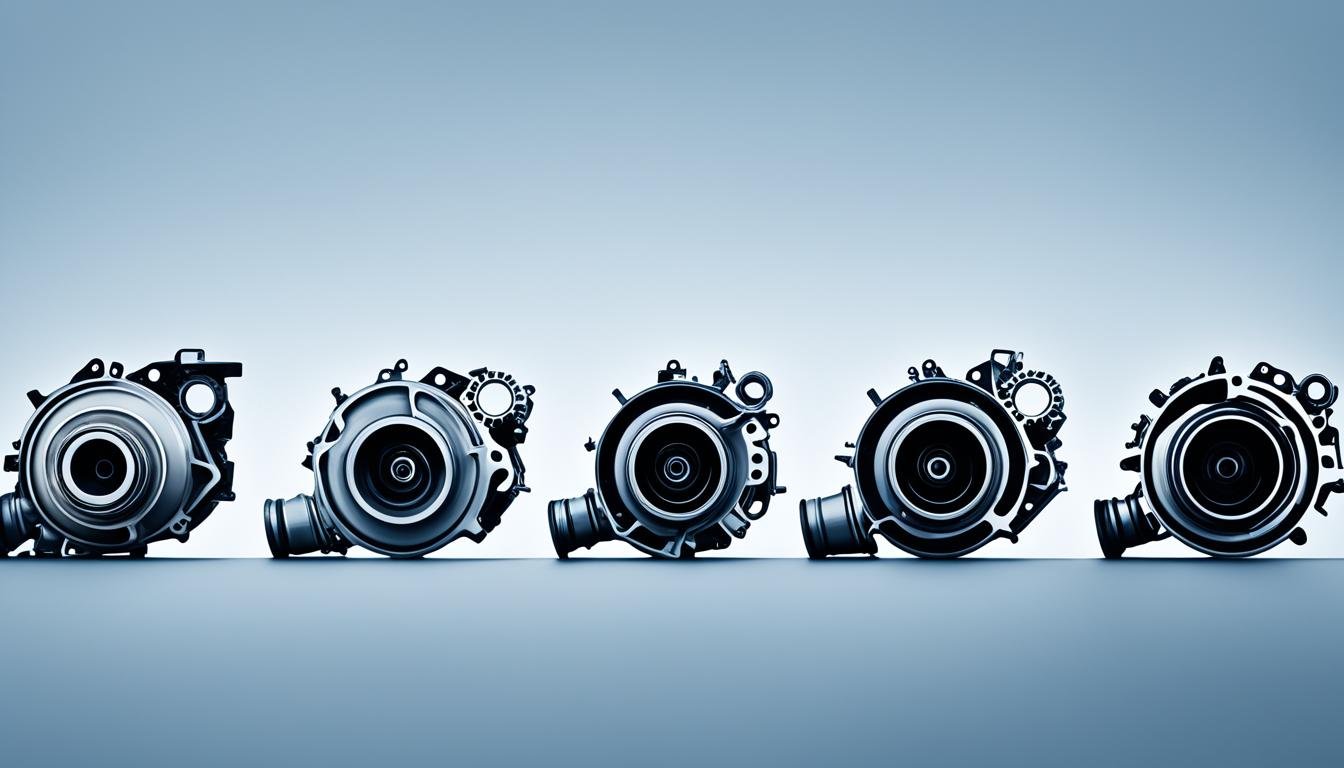The story of turbocharging started in the late 1800s with Gottlieb Daimler and Rudolf Diesel. They were the first to try making engines work harder. Then, Alfred Buchi made a big step in 1896 by inventing the first useful turbocharger.
Later, in the early 1900s, Sanford Moss from General Electric did important tests. He figured out how to keep engines strong at high places. This was key for using turbochargers in airplanes.
In the 1920s, turbocharged planes reached new heights, going over 33,000 feet high. World War II made turbochargers even more important for planes. They made planes go faster and use less fuel.
The Garrett Corporation started in 1936 and faced big challenges in the 1960s. This led to big improvements in turbocharging cars from the 1970s to now.
Since then, turbocharging has made big strides. The first turbocharged diesel car came out in 1978. It was the Mercedes-Benz 300SD and it was great for the environment and performance.
Turbochargers became key in the 1970s for diesel trucks because of new rules on pollution. By the late 1980s, they were common in cars and racing. They won in big races like Formula 1 and the World Rally Championships.
Looking ahead, turbochargers are seen as a smart choice for saving fuel and cutting down on pollution. They work well in small cars and are better than regular engines in many ways. Turbocharged diesel cars are also good for the planet and use less fuel than hybrids or electric cars.
Pioneers of Turbocharging: From Alfred Buchi to General Electric
The story of turbocharging starts with Swiss engineer Alfred Buchi. He filed the first useful turbocharger patent in 1896. Buchi’s work was a big step in engine technology. It led to the turbochargers we use now.
Swiss Mechanical Engineer Alfred Buchi
Buchi found a way to use engine exhaust to increase power. His design used exhaust gases to make more air go into the engine. This was a big change for engine performance and efficiency.
General Electric’s Turbocharger Breakthrough in the Early 1900s
General Electric started making turbochargers in the early 1900s. They were interested in using them in airplanes. Sanford Moss, a top engineer, worked hard to make turbochargers work well at high altitudes. He tested them at Pike’s Peak in Colorado.
His work made turbochargers popular in airplane engines. This brought turbocharging into aviation.
The work of Alfred Buchi and Sanford Moss was key to turbocharging’s early success. They set the stage for big changes in the future.
| Year | Milestone |
|---|---|
| 1806 | François Isaac de Rivaz invented a hydrogen-powered engine |
| 1885 | Gottlieb Daimler patents the first supercharger |
| 1905 | Alfred Büchi patents the turbocharger |
| 1892 | Rudolf Diesel patents the Diesel engine |
| 1899 | Ferdinand Porsche creates the Lohner–Porsche, the first hybrid vehicle |
The Turbocharged Aviation Revolution of the 1920s
In 1920, a big change happened in aviation. The first turbocharged plane, a LaPere bi-plane, went up really high. It reached over 33,000 feet with no loss of power. This showed that Turbocharged Aviation was going to change everything.
By the mid-1920s, Turbocharging in Planes was not just for planes. Turbocharged engines started being used in ships and trains too. During World War II, turbochargers made fighter and bomber planes go faster and use less fuel.
The 1920s were a big time for High-Altitude Turbocharged Aircraft. They brought a new era of speed and technology to aviation and Turbocharging in Transportation. Turbocharging became a key part of how we think about power and speed today.
- In the 1920s, turbo-supercharging was made for diesel engines in ships and trains that worked in a limited way.
- Before World War II, turbocharged engines were added to gasoline planes to help with power at high altitudes.
- By the 1950s and 60s, turbochargers were used in cars, making them faster for racing.
The 1920s were a key time for aviation. The start of Turbocharged Aviation changed the industry a lot. It led to the rise of High-Altitude Turbocharged Aircraft and more use of Turbocharging in Planes. This set the stage for the future of transportation and more progress in Turbocharging in Transportation.
Turbo Titan: The Birth of Garrett Corporation in 1936
In the turbocharger industry, Garrett Corporation is a giant. It started with J. C. “Cliff” Garrett in 1936. Their first product was a charged air cooler for the B-17 bomber. This was their first step into pioneering automotive turbochargers.
In 1954, Cliff Garrett saw the big potential of turbochargers. He split the turbocharger division from the gas turbine division. This created Garrett Automotive, a company that would change the turbocharger world. They started with aircraft and soon changed the game in automotive performance.
Chevrolet Corvair Monza
The Chevrolet Corvair Monza in 1962 was a big step for Garrett Automotive. This car had a turbocharged engine. It showed how turbocharger technology could make cars go faster.
Oldsmobile Jetfire
Garrett Automotive also made a splash with the Oldsmobile Jetfire in 1962. It was the first car with a turbocharger. This car proved Garrett could solve the challenges of early turbocharged vehicles and offer new solutions.
Garrett Automotive led the way in making turbocharging common in cars. Their work on turbocharger technology has made a big impact. They are seen as a Garrett Corporation that changed the turbocharger industry.
Breakthroughs in Automotive Turbocharging: From the 1970s to Today
The 1970s were a big change for car turbochargers. Motorsport led the way in new tech. Turbochargers became famous thanks to Formula 1 racing in the 1970s.
By the end of the decade, turbocharging was well-known. Turbo technology kept getting better. BMW brought out the 2002 Turbo in 1973, but it had some issues.
Later, Porsche’s 911 Turbo in 1974 changed everything. It became the fastest car you could buy, proving turbochargers were key.
The 1970s also saw turbodiesel engines start to appear. Mercedes-Benz’s 300SD, with a Garrett turbocharger, was a big hit in 1978. This made diesel engines better and cleaner.
By the 1970s end, turbodiesel engines were big in Europe. They made up almost half of all cars there.
Source Links
- https://www.turbosmart.com/news/history-of-turbocharging/
- https://www.turbocharger.mtee.eu/a-history-of-turbocharging/
- https://library.e.abb.com/public/90afc44dee46dde9c12572ff002fc62c/85-90 2M750_ENG72dpi.pdf
- https://en.wikipedia.org/wiki/Timeline_of_motor_and_engine_technology
- https://digital.wpi.edu/downloads/8336h599w?locale=it
- https://en.wikipedia.org/wiki/History_of_the_internal_combustion_engine
- https://grassrootsmotorsports.com/articles/history-turbocharger/
- https://fredstarr.com/wp-content/uploads/10.-First-50-Years-of-Aircraft-Engines-Schaad.pdf
- https://en.wikipedia.org/wiki/Supercharger
- https://en.wikipedia.org/wiki/Gas_turbine
- https://downbeat.com/?/news/detail/yuletide-music-roundup/P2
- https://www.science.gov/topicpages/a/ab-ramjet space propulsion
- https://www.carthrottle.com/news/brief-history-turbochargers-cars
- https://goldfarbinc.com/blogs/news/first-turbocharged-car
- https://www.popularmechanics.com/cars/g2778/most-important-automotive-tech-milestones/

